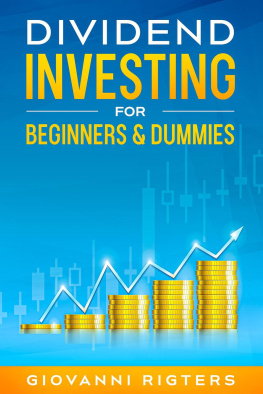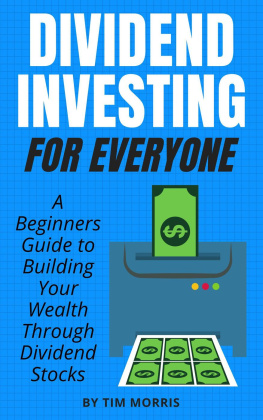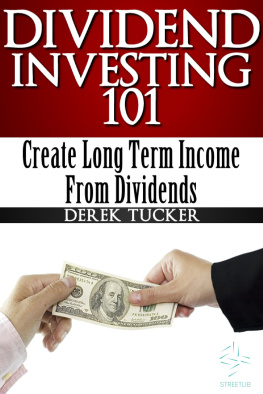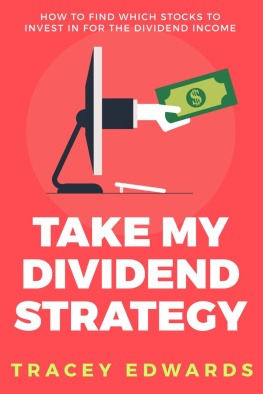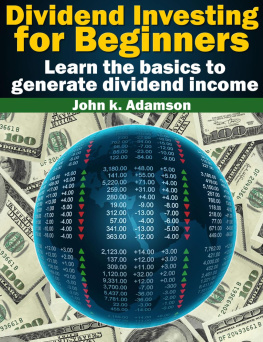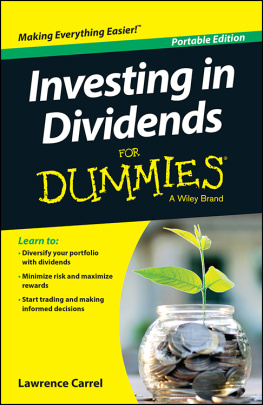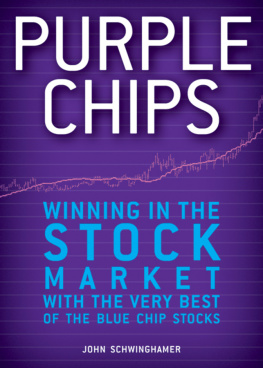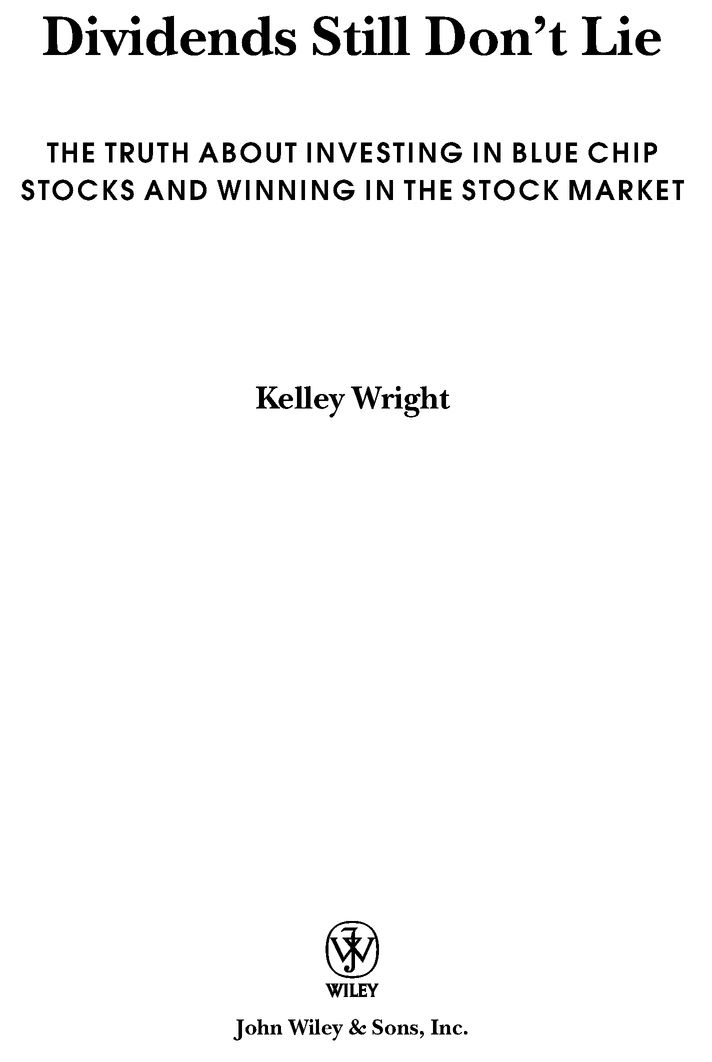Table of Contents
Table of Figures
Praise for the original Dividends Dont Lie (1988)
Geraldine Weiss, the doyenne of dividend enhancement, has popularized the theory that there is an inescapable relationship between the corporations ability to pay consistent dividends over time and its price performance in the stock market. Her respected newsletter, Investment Quality Trends, employs this theoretical basis, and her classic Dividends Dont Lie is a primer on her theory.
Library Journal
Geraldine Weiss dividend yield investment model espoused in Dividends Dont Lie is basically reiterated and confirmed. This relatively simple,straightforward strategy, limited here to 350 select blue-chip stocks, has regularly outperformed the market (as documented by Mark Hulbert, who tracks investment advisers in his Hulbert Financial Digest).
Booklist
In their technically detailed, conservative analysis, the authors recommend careful study of high grade issues with steady dividend-increase records. Investors should buy shares when the stock is undervalued in relation to dividend yield, then sell (reinvesting elsewhere) when a bullish trend drives the share price up to an overvalue level.
Publishers Weekly
The first dividend accrues to the reader when you buy Dividends Dont Lie. It is a superb value.
Bob Gross, Publisher, The Professional Investor
A lucid and powerful presentation of one of the best documented investment theories.
Peter Brimelow, Senior Editor, Forbes
Finally, an investment book that deals with values! Values ultimately rule the market and a knowledge of values is always based first and last on dividends. This book should be the bible of dividends.
Richard Russell, Publisher of Dow Theory Letters
I have a lot of respect for the common-sense approach of an investment strategy based on dividends. There is a wonderful order and simplification in this long-term skill which tends to achieve profits by patience rather than clever short-term market moves which do not create income or build capital.
James L. Fraser, CFA, President, Fraser Management Associates
To my late grandfather,
Elbert Nelson Dummitt,
my first teacher and mentor.
Foreword
It is with a great deal of pleasure that I introduce Kelley Wrights new book about the dividend-yield approach to lifelong growth of capital and income in the stock market.
This investment concept first was published in 1966 in what then was a new investment advisory service, Investment Quality Trends. Forty-three years and three books later, the service is still helping investors master the stock market by investing in high quality, dividend paying, blue chip stocks. It helps them know when stocks are undervalued, when they can be bought, and overvalued, when they should be sold.
The importance of dividends in determining value in the stock market cannot be overstated. The main reason investors are willing to risk their capital in anything is to get a return on their investment. In the real estate market, that return is rent. In the money market, it is interest. And in the stock market, it is a cash dividend.
Folks who ignore the importance of dividends in making stock market selections are not investors. They are speculators. Speculators hope that the price of a stock will go up and reward them with profits. Investors know that stocks that pay dividends go up too. Meanwhile, they are getting a return on their capital. They believe the old adage: A bird in the hand is worth two in the bush.
The legendary Charles Dow has written, To know values is to know the meaning of the market. And values, when applied to stocks, are determined in the end by the dividend yield.
It is undeniable that many stock market investors are attracted to companies that pay dividends. Unconsciously, investors have established profiles of value for each dividend-paying stock based on historic extremes of high and low dividend yield. Those extremes of yield provide profitable buying and selling areas. A stock is undervalued when the dividend yield is historically high. It is overvalued when the price rises and the yield become historically low.
Let us examine how and why dividends create value in the stock market.
When the price of a stock declines far enough to produce a high dividend yield, value-minded investors who seek income begin to buy. The further the price falls, the higher the yield becomes and the more investors are drawn to the stock. Eventually the stock becomes irresistibly undervalued, buyers outnumber sellers, the decline is reversed and the stock begins to rise. The higher the price rises, the lower the dividend yield becomes and fewer investors are attracted to the stock. Meanwhile, investors who purchased the stock at lower levels are inclined to sell and take their profits. Eventually the price becomes so high and the dividend yield is so low, sellers outnumber buyers and the price of the stock begins to decline. A declining trend generally continues until a high dividend yield is reached that again attracts investors who step in and reverse the trend. At undervalue, the price/yield cycle reestablishes itself and the journey from undervalue to overvalue starts all over again.
It should be noted that each dividend-paying stock etches its own individual profile of value. These profiles of high and low dividend yield are established over long periods of time. There is no one-size-fits-all. Some stocks are undervalued when the dividend yield is 4.0 percent. Some, when the yield is 5.0 percent. Some will decline to yield as much as 6.0 percent or even 7.0 percent before they are historically undervalued. Some growth stocks are undervalued when the dividend yield is as low as 2.0 percent or 3.0 percent. The yields at overvalue are similarly distinctive and individual. Therefore each stock must be studied and evaluated according to its own unique profile of dividend yield, one that has been established over several investment cycles.
Now, here is the best part. Every time a dividend is increased, the prices at undervalue and overvalue move higher to reflect the historically established high and low dividend yields. Therefore, a company that has a long history of consistent dividend increases is most desirable. It promises steady growth of capital as well as continuous growth of dividend income. Frequent dividend increases prolong the life of an investment by raising the price/yield targets at undervalue and overvalue.
Dividends are the most reliable measures of value in the stock market. Earnings are figures on a balance sheet that can be manipulated for income tax purposes. Earnings can be the product of a clever accounts imagination. Who knows what secrets lie in the footnotes of an earnings report? Dividends, however, are real money. Once a dividend is paid, it is gone forever from the company. There can be no subterfuge about a cash dividend. It is either paid or it is not paid. When a dividend is declared, you know that the company is in the black. And when a company increases its dividend, you dont have to read a balance sheet to know that the company has made profitable progress. In short, dividends dont lie.
But nothing is perfect in the stock market. There is one problem with the dividend-yield approach. Sometimes an unusually high yield can send a signal that the dividend is in danger of being reduced. When a dividend is lowered, the prices at undervalue and overvalue also are lowered and a price that previously was undervalued no longer represents good value. Therefore, it is critical to make sure that the indicated dividend is adequately covered by earnings.








